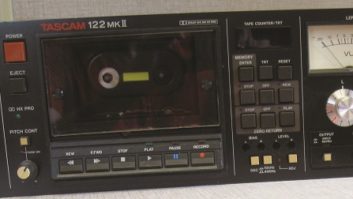The Cart Chunk standard
Mar 1, 2002 12:00 PM, By Kevin McNamara, CNE
Long before the dawn of affordable desktop computers, seamless file exchange was an issue. The problem of file incompatibility is found primarily at two levels: between different platforms or operating systems and between applications generating data files that utilize proprietary formats. I still find it odd that some 20 years later many of these problems still exist, however third party products such as Adobe Acrobat permits virtually any file that can be printed to be saved in a single format readable on most platforms and operating systems.
Compatibility between the files produced by digital audio production and storage equipment has been a major obstacle for engineers attempting to mix and match products from different manufacturers within a facility. Within the past few years, a great deal of progress has been made in the creation of a uniform set of standards for files that are interchangeable. The WAV format has become the basis upon which these new standards were created. The European Broadcast Union (EBU) led the development for the standard called Broadcast Wave File (.BWF), which expanded the basic WAV format to include meta information, permitting a wide range of flexibility with respect to the types of different audio file formats and other information that can be exchanged.
Table 1. The fields used in the Cart Chunk standard

While it was important to have this level of audio compatibility between different types of equipment, files created and stored in digital file formats lacked perhaps the most useful and familiar attribute: how to identify the content of the file? More importantly, how can this information be exchanged with different digital audio equipment, i.e. between digital audio workstations and storage systems?
In the recent past, most every station used a cart machine to play spots and, in fact, some time between the elimination of turntables and the acceptance of broadcast-specific CD player machines in the studio, many stations put music on carts. The rationale to use carts for music revolved around an ever shorter music rotation and the program director’s desire to make sure the jock doesn’t play the wrong cut. Another advantage of the cart was that each one could be labeled with a cornucopia of information that ultimately needed to be transferred to a music or program log.
Digital audio storage systems make short work of the job of logging information specific to the particular commercial spot or music cuts. In a perfect world, data indicating what was run and when should automatically be transferred to/from the appropriate traffic or music rotation system.
Earlier versions of digital audio workstations generally provided a means to enter several pieces of information about the particular track within its audio file; however, in many cases the file was created in a proprietary format not compatible with the system that would ultimately store the track for replay. Worse yet, the information about that track was difficult, if not impossible, to export into third party traffic and/or music rotation systems.
WAV files
The origin of the .WAV (waveform data) file is defined in the Resource Interchange File Format (RIFF) developed jointly by Microsoft and IBM as “a means of storing digital audio files.” WAV files can support either Pulse Code Modulated (PCM) non-compressed audio or other compressed encoding schemes, such as MPEG, ADPCM or G.721. RIFF files define a structured framework that may contain other existing data formats and specifies the layout of certain public chunks with respect to order, what type?, etc. These formats are typically related, but not limited to, the storage and delivery digital multimedia files. Examples of existing file formats that are stored within the RIFF framework include Audio-visual interleaved data (.AVI), MIDI information (.RMI), Animated Cursor (.ANI), Waveform data (.WAV) and of course the Broadcast Wave File. Consider that RIFF files are simply a framework that hosts a collection of chunks.
What is a chunk?
By definition, a chunk is “self-contained collection of data in a RIFF file.” Specifically, the data takes the form of a fixed length string that contains a 4-character chunk identifier spelled out in alphanumeric text such as “cart,” followed by a 32-bit chunk length indicator which describes the size of the data portion of the chunk. Chunks provide a simple and effective method to embed and distribute different types of information within the standard .WAV (or .BWF) formats.
In addition to the cart chunk proposal, which is also called AES-X87 International standards organizations such as the EBU and the Audio Engineering Society (AES) have proposed a new chunk, AES-31, that permits wave files to carry multichannel audio plus information and a chunk that can be used with audio files specific to the film industry.
Its name, likely derived from the information that was found on the labels attached to carts, the “Cart” Chunk format provides a means to embed basic radio traffic information and continuity data within a BWF file. The Cart Chunk standard currently provides 20 fields of information, as shown in Table 1.
The Cart Chunk standard is currently under final review by the SC-06-01 committee on file formats with the expectation of full adoption in late 2002. At this point, several manufacturers of digital equipment have included the Cart Chunk into its data. To learn more about the Cart Chunk standard point your browser to www.cartchunk.org.
Kevin McNamara, BE Radio’s consultant on computer technology, is president of Applied Wireless Inc., New Market, MD.
All of the Networks articles have been approved by the SBE Certification Committee as suitable study material that may assist your preparation for the SBE Certified Broadcast Networking Technologist exam. Contact the SBE at (317) 846-9000 or go towww.sbe.orgfor more information on SBE Certification.






